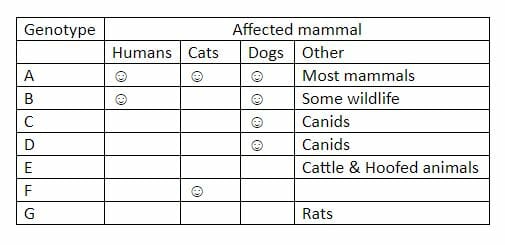What is Giardia?
Giardia was first discovered in the 1600s by Antony van Leeuwenhoek while studying a sample of his own stool. Giardiasis is a common intestinal disease found in our pets all around the world. It is a single-celled protozoan parasite, it is NOT a worm, bacteria or virus. Giardia is commonly known as travellers’ diarrhea or ‘beaver fever.’ Giardia has two forms. First is a fragile feeding form that lives in the gut of its host; called trophozoite. Second, is a cystic form. This cystic form is harder then it’s counterpart and is shed in the feces of its host. Due to its hard outer shell, the cyst can live in the environment for several months. If the environmental conditions are damp or wet, the cyst can survive even longer! There are seven genotypes. The table below illustrates the different genotypes and the animals they affect.

How do our pets get giardiasis?
Our pets can pick up giardia by sniffing the contaminated ground, licking their paws after contacting the contaminated ground or by drinking contaminated water. Once the parasitic cyst has entered our pet’s intestines, the cyst transforms to the trophozoite stage and attaches to their intestinal wall. From this point, they feed and multiply. Reproduction for trophozoites is a matter of dividing itself in two. In 5-12 days for dogs and 5-16 days for cats, the pet will pass infectious cysts in its stool, infecting the environment around it. In small amounts, these parasites can go undetected. Only if there is a sufficient amount of trophozoites in the pet will clinical signs show.
What to look for?
For the most part, you will be looking for sudden foul smelling diarrhea. Weight-loss, intermitted diarrhea and fatty stool can also be seen in infected animals. Their stools often have a greenish tinge. They may also range from soft to watery and sometimes may contain blood. Vomiting and lethargy have been observed in some cases. As the disease continues, weight loss may become apparent as nutrients are not being absorbed as easily, as well from diarrhea.
Giardiasis is not normally life-threatening to a healthy animal. In a young puppy/kitten or an immune compromised pet, it can be more severe, and even result in death. All pets diagnosed with giardia should be retested in two to four weeks after treatment is completed.
How do I know my pet has giardia?
A fecal float can be done at your veterinary clinic to detect if cysts are present in the stool. Most often fecal floats require a special flotation solution, and on occasion, your veterinarian will see the parasite on a direct smear of the stool. Since they are shed inconsistently in the stool, often a tentative diagnosis is made through medical history and clinical signs.
How is giardia treated?
Your Veterinarian will prescribe you one of two antibiotics for three to ten days. In some cases, fluid therapy and diet changes are required.
Can I become infected?
Looking back to our chart above, you can see two genotypes can affect us. If infected with these genotypes; yes – our infected pets can infect us. We will also have similar clinical signs as our pets.
If your pet is infected, always wash your hands after playing with them. Pick up feces as soon as they are deposited to lessen the environmental contamination. WASH YOUR HANDS after dealing with feces. Our pets do like to clean themselves, so ‘kisses’ might have to wait until the final test after treatment has been administered.
Written by: Chelaine, CCR & Nutrition Consultant